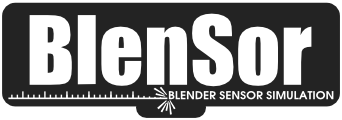Simulation result
ATTENTION: This is not the data from the scanner of the UBER car. It is a simple approximation of a car approaching at 17 meters per second to a pedestrian with a bicycle.
Scanned with a virtual Velodyne HDL-64E. The output is the "raw" noisy scan without further calibration. Reflectivity has not been considered, but at a closer distances this should not affect the accuracy of this representation.
The scanner is mounted at a height of 2 meters above ground. This is a rough estimate of the mounting position where UBER has mounted the scanner.
Distance to pedestrian: 34 meters
Scanning rate: 10Hz
Angular resolution: 0.1728 degrees
FPS: 1000
Explanation of rotation speed vs. frames per second vs. angular resolution
The point rate of the Velodyne scanner is constant (roughly 1.33 Million points per second). This means the spin rate of the sensor is directly related to the angular resolution of the scan. Faster spinning means less angular resolution.
In Blensor the spin rate can be set independently from the angular resolution. The scan is done in discrete timesteps and the rotation speed only relates to the resolution with respect to the time interval not the angular resolution. If the FPS is set to 25, each second will be split in 25 equal parts and all scanning angles within a frame are scanned from the same position.
In a completely static scene this does not matter, since the position of the scanner and all objects don't change over time and the only factor that has an impact is the scanning resolution.
However if the scanner is moving very fast, one full revolution per frame would be an inaccurate representation because the scanner will have moved considerably between the beginning and the end of the frame.
The user can decide how granular the mapping between scanning angles and time is. For example, if the simulation is at 1000fps and the scanner runs at 10Hz, each rotation will be distributed over 100frames, one frame covering only 3.6 degrees of the full rotation. If the simulation is at 25fps and the scanner runs at 10HZ, each rotation will be distributed over 2 1/2 frames each frame covering 144 degrees of a full rotation.
The rotation speed is only relevant for the accuracy of the simulation with respect to moving objects, if the scene is stationary it won't change the simulation except for distributing the scan over more/less frames.
The angular resolution defines how far the scanner rotates between each set of laser beams. This is the parameter you want to set to correctly represent a fast/slower spinning scanner.
The parameters for angular resolution (taken from the Velodnye manual are):
| Rotation speed |
Angular resolution |
| 5Hz |
0.0864 |
| 10Hz |
0.1728 |
| 15Hz |
0.2592 |
| 20Hz |
0.3456 |
Credits
The environment is modeled after satellite images from Google Maps and views from Google Streetview.
Google Maps link to the location: 642 North Mill Avenue, Tempe, Arizona, USA
The models used are from blendswap.com
Name: Mountain Bike [Unibike Mission 2010]
Author: hilux.
Permalink: http://www.blendswap.com/blends/view/72436
Name: Very Low Poly Human Basemesh
Author: tweediez.
Permalink: http://www.blendswap.com/blends/view/55698
 Blender Sensor Simulation
Blender Sensor Simulation 